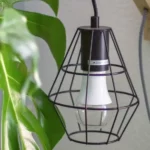OK, you want to know if Monstera can live and grow in water. I can tell that by reading your question. And as an expert gardener, I would like to share my knowledge on this subject. Let’s get started and find the answer to this question together!
Table of Contents
Can Monstera Live In Water?
While the majority of Monstera owners have experimented with propagating a stem in water, have you ever wondered whether you could just let your Monstera grow in water for an extended period of time?
Most advice on water propagation implies that the plant will be transplanted to soil soon, but what if you keep your Monstera plant in water forever?
Can a monstera grow in water? Monstera can be grown in water for a long time, but it will never achieve its full potential in terms of growth or health until it is shifted to soil. Your Monstera that is kept in water will be able to live, but it will not be able to flourish.
After considering the distinctions between growing plants in water and growing them in soil, I feel that it is preferable for the plant to be shifted to soil at some point in the future.
Using propagation and cuttings may be a lot of fun, even if I wouldn’t trust the health of my Monstera to the elements.
If you want to attempt growing a Monstera in water, you can, but there are a few tips and tactics to assist you along the way.
Read More: Monstera Deliciosa Fruit – A Complete Guide
Can a Monstera Live in Water?

The answer is yes and no, as it is with so many houseplant questions. As long as the cutting has a node, a Monstera can live in water for a long time.
I’ve heard of individuals growing their Monstera cuttings in water for years! However, there are certain limitations to what you can really anticipate if you grow your Monstera plant in this manner.
It seems to reason that our houseplants thrive when we can mimic their natural surroundings as nearly as possible. When you grow monsteras in a watery environment, you’re forcing them to adapt to conditions they wouldn’t encounter in the wild.
Because Monsteras are so flexible, they may thrive in a wide range of environments. Because of their flexibility, they can be effectively grown indoors.
Even though they can live in water, they will not grow as large or as healthy as a Monstera that is given a container of well-draining potting soil mix and given an opportunity to climb.
If you are anything like me, one of the most appealing aspects of Monstera is its capacity to develop into a massive showcase.
In the pros and cons section below, I’ll go over some of the reasons why a person would wish to keep his or her Monstera plant in water for a long period of time.
Read More: Can Monstera Grow In Water Forever?
Will Monsteras in Water Continue to Produce New Leaves and Growth?
Within a few weeks of being put in water, Monstera cuttings usually begin to develop roots. If the plant is receiving enough light, a new leaf or two will normally appear soon after.
However, when grown in water, Monsteras do not reach their full potential. Because the habitat is artificial, the plant does not get the full amount of resources that it might utilize to grow and develop. In the absence of soil, the plant’s size will stay smaller, and its leaves will not be able to achieve their full potential.
Typically, you’ll see a pattern in which the plant keeps producing new leaves, but with each new growth that appears, an older or bigger leaf falls off. Despite the fact that it produces new growth, the plant remains essentially the same size.
Read More: Does Monstera Grow Faster In Water?
How Long Can Monstera Live in Water?
It’s hard to say how long a Monstera cutting will last in water. If a plant isn’t growing well, most owners will attempt to fix the problem, therefore there aren’t many occasions when a cutting lies in water till it dies.
Is it possible for a Monstera to die here if it didn’t have the perfect conditions? (for example, frequent water changes and added nutrients).
Having said that, based on anecdotal evidence, it seems that many cuttings begin to exhibit indications of stress around 2 – 3 years in water. As previously said, there are certain instances in which they may endure for a longer period of time, but such are the exception rather than the rule.
Read More: How Long Can A Monstera Stay In Water?
Growing Monsteras in Water: Pros and Cons

While it’s possible that your Monstera may wind up living in water for a while simply because you haven’t gotten around to planting it yet.
some houseplant enthusiasts choose to keep their Monstera deliciosa and other tropical plants in water on a long-term basis. There are various explanations for this, some of which are extremely compelling!
Pros of Leaving Monteras Growing in Water
Pest Probability Is Reduced
It will be impossible for bacteria and molds that thrive in or on plant soil to survive if the soil is removed.
Infestations of gnats in indoor potted plants are one of the most bothersome drawbacks, therefore getting rid of them is undoubtedly desirable.
The plant may be hosed down without fear of overwatering, which makes it a good choice for treating insects that dwell on the plant’s stems and leaves (such spider mites, aphids, and thrips).
The House is free of soil
This may be a huge advantage for pet owners whose pets prefer to dig in their potted plants. Others just find the thought of having “dirt” within their house unusual and uncomfortable, and are far more at ease with water.
It’s easier to see whether it’s murky or if it’s developing algae since it’s less messy. A container of soil, on the other hand, covers everything under the surface, making it more mysterious.
Prevent Overwatering
If you have a problem with over-watering your houseplants, you may like growing them in water.
It may sound contradictory to imply that growing plants in water may help you prevent overwatering, but it works because they develop special water roots intended to absorb just the appropriate quantity of water. Compared to soil roots, water roots are more delicate and tiny.
Pots
In order to keep my plants happy, I always ensure that the drainage holes in my containers are set properly. However, some of the most beautiful ornamental pots do not have drainage holes!
If you are growing your Monstera plant in water, you may utilize those pots that do not have drainage holes, or any other container. The use of vintage jars and vases is trendy.
Root Health Can Be Easily Monitored
Your Monstera’s roots will be visible, and you will be able to identify any broken or rotten roots and remove them right immediately.
It helps “Plant-Sitters.”
People who often travel may worry about entrusting their houseplants to family members or friends who may not be as knowledgeable about plant care. It is far simpler for those individuals to replenish or top up a container of water than it is for them to comprehend moisture levels and the unique requirements of each plant.
Cons of Leaving Monsteras Growing in Water
Potential for growth is limited.
If you want a majestic Monstera in your home, don’t expect it to grow that tall in water. In a less-than-ideal environment, the plant will restrict its own growth in order to preserve energy. If you’re attempting to keep your Monstera compact, this may work in your favor.
No Nutrients from Soil.
If you keep your Monstera plant in water for a long time, it will lose some of the nutrients that it would have taken from the potting soil over time. In certain cases, specific fertilizers may be required to help make up for the lack of essential nutrients.
Concerns Regarding pH Levels
Although I’m not a specialist in water pH, my knowledge is that if the level is wrong, the plant may have difficulty absorbing nutrients. If you want to grow a lot of plants in water, you may need to use test kits and other additions.
How to Grow a Monstera in Water?

- If you plan to grow your Monstera in water for a long period of time, there are a few things to keep in mind. To begin with, it will still need a lot of bright, indirect sunlight to thrive. Monsteras aren’t fussy about humidity or temperature, but they do need plenty of light to thrive (regardless of if it is in soil or water).
- Ideally, the water must be changed every two to three days, but once a week is sufficient. Plants need oxygen to “breathe” and can only do so when the water is changed often. Potted plants have sufficient space for oxygen to move inside the soil, but when a plant is merely submerged in water, the oxygen will decrease over a period of time
- Maintaining a regular change of water helps to minimize any cloudiness that may arise, which is generally caused by some plant material dissolving in the water. Remove any mushy or slimy sections of the plant, since these are indications of rot, which is terrible for the roots of your plant.
- The roots should also be rinsed and checked when you replenish the water. Algae may form on the roots or container when the water is in a transparent container. It is true that this does not harm the plant, yet it is considered unattractive by many. Algae may be prevented by using an opaque container or transferring it to a less sunny location.
What Is the Best Water for Monsteras?
When you’re going to be growing your Monstera for an extended period of time in water rather than soil, the quality of the water becomes even more critical. Because all-purpose fertilizers are frequently included in commercially available potting mixes, the plant will no longer have access to them when growing in water.
There is no substitute for rainwater when it comes to watering plants of any kind, and this is no different. Chlorinated tap water is the worst choice accessible to the majority of us. This is due to the presence of chemicals and salts in tap water.
A buildup of tap water pollutants may harm plants, particularly those planted in a container in an indoor environment. The chlorine in tap water can get rid of itself if you leave it out for a few hours.
One of the reasons rainfall is so beneficial to plants is because it carries nutrients already. Rainwater naturally provides your plants with nitrogen in a form that is easily absorbed. Most plants enjoy it since it’s somewhat acidic. Rainwater, on the other hand, is significantly less likely to contain contaminants than tap water.
If you don’t have access to rainwater, spring water will suffice. Using well water on your plants is a good idea if you have access to it; however, you should test it beforehand since there may be heavy metals or other toxins in the water. It doesn’t matter what water you use, but nutrient-rich water is the ideal option for Monsteras.
Water-Growing Monstera Fertilization
Monsteras are less able to acquire nutrients when grown in water than in potting soil. Monsteras, like the majority of indoor plants, benefit from the addition of a fertilizer containing a combination of nitrogen, phosphorus, and potassium.
Plants grown in water may not be able to get the nutrients they need from regular fertilizer because they lack the nutrients that would be present in the soil. Because of this, I suggest using a hydroponic fertilizer. Make sure to carefully follow the recommendations to prevent overdosing, which might cause harm to your plant.
Keep in mind that I do not use fertilizer while rooting Monstera cuttings that will be put in soil later since it is unnecessary. Only Monsteras which will be grown in water for an extended period of time should use hydroponic fertilizer.
How Long Can Monstera Leaves Survive in Water Without a Node?
Even if you don’t intend to propagate it, a Monstera leaf may still be attractive in water. Monstera leaves are often used in floral arrangements, and they are likely to outlive the majority of the cut flowers in the arrangement.
In certain cases, some fledgling roots may be seen emerging at the stem base, which has led some people to question whether it is feasible to grow a new plant from a single leaf.
Unfortunately, a leaf’s lifespan is limited to a few weeks unless it possesses a node. Changing the water every few days will prolong the life of the leaf, but in the end, it will die like any other cut flower.
Conclusion
Should You Grow a Monstera in Water Permanently?
Is it possible to keep a Monstera in water for the rest of time?
Of course, the decision to experiment with growing a Monstera in water is entirely up to you. The advantage of this is that you don’t need much in the way of specialized equipment, and the risks involved are minimal as well.
Even though your Monstera cutting may initially thrive in water, if it begins to show signs of disease, you may easily transplant it to soil and see if it improves.
The fact that Monsteras can thrive in a variety of environments, as well as the fact that they are often affordable and simple to acquire, makes them the ideal plant with which to explore and play with the idea of growing in water forever.
Photo by Tim Douglas from Pexels
Woman photo created by nakaridore – www.freepik.com
People photo created by cookie_studio – www.freepik.com
Photo by Tim Douglas from Pexels


